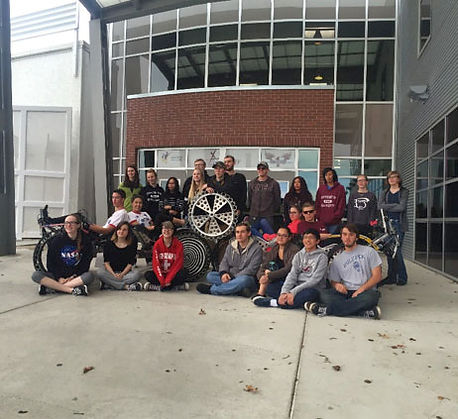
Trebuchet
by Gregg Symonds
Back in November of last year schools from all around the Reno/Sparks area competed to create a
trebuchet that will fire close to 750Ft. AACT took 2 nd in this year’s competition. This is the first year of
the competition but it will be held annually from now on.
On our schools first throw a piece of the machine fell and got in the way of the throwing arm, causing a
catastrophic fail, which destroyed the throwing arm and the left mast.
The old design sat at 30Ft tall at the top of the throwing arm and, 22Ft at the top of the mast. The base
is 3Ft wide and 13Ft tall. The arm had to be lifted into the trebuchet with a high-powered forklift. Then
the masts had to be lifted into place and bolted down with 3 bolts a side. This posed many problems
when we had only a short area to set up, along with the safety issue of large metal parts being held in
the air.
The seniors and juniors in the Engineering Academy are in the middle of rebuilding the trebuchet. They
recently got the metal needed to complete the rebuild. They are leaving the base as it is but with a few
modifications. The masts are going to be shortened by a few feet and the throwing arm is going to be
able to be kept in the machine with a new hinge system on it. The major systems of the trebuchet,
including the firing system, the holding position and, the wench system, are all getting redesigned by
Dexter Bush.
Next year’s competition will be held at a new location which allows us to throw at maximum power. Last
year it was held at a field that was close to a construction zone causing us to have to throw at only 40%
power. By the end of May they hope to have a working trebuchet that will be tested at Dexter Bush’s
home.
NASA Rover
by Gregg Symonds
A few weeks ago the AACT NASA Human Exploration Rover team competed in Alabama against
other high schools from around the world. The away team consisted of Dexter Bush, Natalie Fox,
Danielle Kiserow, Irene Dettaan, Christian Oaks, Owen Schnek, and Madelyn Newcomb. The team took
3 rd in the High school division and won the safety system award.
This year the team also competed in a sample collection system. It is a competition where the teams
have to make a holding container and collection arm to go around the course colleting samples of both
solid and liquid.
This year’s rover had to meet requirements given by NASA. These included a 50% modification rate from
the previous year’s rover. The tires could not be bought from any store, and there could not be any air in
the tire. After eight failed designs, the team came up with a design that covered all these parameters.
They used aluminum rims that they made from a flat sheet. It started with the design being cut out with
a plasma table. Then they used a dimple dye to make a slight bend in the overall rim as well as making
the holes able to hold more weight. They also had 2 pieces of aluminum L angle bended into the shape
of the rim. This was then rolled into a circle to fit over the top of the rims. For the hub they used a CNC
mill to cut out the hub from a solid aluminum rod about 3 inches across.
For the tires, they used a modified version of last years tire. A special plastic tubing that is resistant to
bending was used as tread. It is held on with 2 metal braided cords that are threaded through 2 holes
that are drilled through the sides. It is then tightened down with a turnbuckle. This is all done on the
aluminum rims talked about in paragraph 3.
I can’t wait to see what the team will do for next year’s rover.
ENGINEERING
by Natalie Fox
APV
The alternate powered vehicle-also known as the human powered vehicle- is a project that AACT will hope to compete in within the next coming year.
Human Powered Vehicles are bicycles with full fairing. The bike gets protection from the wind and rain through the aerodynamic shell. It is a bullet-shaped bike that lets the pilot lean back almost completely horizontal, which utilizes a combination of weight, aerodynamics, and sheer physical endurance that allows these vehicles to reach speeds up to 85 miles per hour.
Once a year, high school and college teams meet at Battle Mountain, NV to try to break the world record of 85.6 miles per hour. Last year, in September of 2015, AACT sent a team of 6 students and 3 teachers to this event to create a feasibility report. 3 students- Adrian Ortiz, Nick Macaluso, and Jordan Buxton- decided to create a feasibility report for their service learning project. The team also took along 3 other students-Natalie Fox, Irene DeHaan, and Grace Wallace. At Battle Mountain, the students were able to speak with other international teams and come up with ideas for AACT’s own bike. Due to this trip, the team was able to decide that having a bike for next year’s competition could be possible. Nick, Adrian, and Jordan were able to create a full feasibility report for their service learning project and hopefully there will be a team next year that is willing to take on this challenge.





